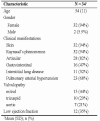Assessment of Neutrophil-Lymphocyte Ratio and Systemic Immune-Inflammation Index in Systemic Scleroderma Patients with Focus on Cardiopulmonary Manifestations
- PMID: 39574823
- PMCID: PMC11578356
- DOI: 10.12865/CHSJ.50.03.09
Assessment of Neutrophil-Lymphocyte Ratio and Systemic Immune-Inflammation Index in Systemic Scleroderma Patients with Focus on Cardiopulmonary Manifestations
Abstract
Objectives: To quantify levels of two inflammation-related indexes, namely neutrophil-lymphocyte ratio (NLR) and systemic immune-inflammation index (SII) in systemic scleroderma patients and determine the association with clinical manifestations and features of heart ultrasound.
Methods: The study group consisted of 34 patients with diagnosis of systemic scleroderma which were admitted to the hospital during 2015-2019. Patient data included the presence and type of clinical manifestations of systemic scleroderma, chest imaging to screen for lung disease, heart ultrasound reports and the laboratory investigations needed to quantify inflammatory indexes. We analysed the levels of inflammatory indexes and compared results based on the prevalence of systemic manifestations.
Results: Higher serum levels of NLR and SII are associated with the presence of joint, lung and pericardial involvement. Statistical significance was observed only for NLR levels with regard to the presence of articular involvement and ILD. Low ejection fraction was also associated with higher levels of both inflammatory indexes, without statistical significance.
Conclusion: Inflammatory indexes are cost-effective markers that reflect active disease manifestations of systemic scleroderma and can thus be a useful tool to include in the regular follow-up of patients in order to better inform organ-specific assessments.
Keywords: Systemic scleroderma; biomarkers; inflammation; neutrophils.
Copyright © 2022, Medical University Publishing House Craiova.
Conflict of interest statement
The authors have no conflict of interest to declare.
Figures





Similar articles
-
Neutrophil-To-Lymphocyte Ratio and Systemic Immune-Inflammation Index-Biomarkers in Interstitial Lung Disease.Medicina (Kaunas). 2020 Jul 29;56(8):381. doi: 10.3390/medicina56080381. Medicina (Kaunas). 2020. PMID: 32751302 Free PMC article.
-
The Clinical Value of the Neutrophil-to-Lymphocyte Ratio, the C-Reactive Protein-to-Albumin Ratio, the Systemic Inflammatory Index, and the Systemic Inflammatory Response Index in Patients with the Anti-Synthetase Syndrome.J Inflamm Res. 2024 Jun 4;17:3617-3628. doi: 10.2147/JIR.S460610. eCollection 2024. J Inflamm Res. 2024. PMID: 38855168 Free PMC article.
-
The clinical value of KL-6 for predicting the occurrence and severity of connective tissue disease-associated interstitial lung disease is not affected by CTD type or treatment.PeerJ. 2024 Aug 8;12:e17792. doi: 10.7717/peerj.17792. eCollection 2024. PeerJ. 2024. PMID: 39131623 Free PMC article.
-
Association between systemic immune-inflammatory markers and the risk of moyamoya disease: a case-control study.Ann Med. 2023;55(2):2269368. doi: 10.1080/07853890.2023.2269368. Epub 2023 Oct 21. Ann Med. 2023. PMID: 37865806 Free PMC article.
-
Unraveling the clinical significance and prognostic value of the neutrophil-to-lymphocyte ratio, platelet-to-lymphocyte ratio, systemic immune-inflammation index, systemic inflammation response index, and delta neutrophil index: An extensive literature review.Turk J Emerg Med. 2024 Jan 8;24(1):8-19. doi: 10.4103/tjem.tjem_198_23. eCollection 2024 Jan-Mar. Turk J Emerg Med. 2024. PMID: 38343523 Free PMC article. Review.
References
-
- Ciechomska M, van Laar, O’Reilly S. Current frontiers in systemic sclerosis pathogenesis. Exp Dermatol. 2015;24(6):401–406. - PubMed
-
- Walker UA, Tyndall A, Czirják L, Denton C, Farge-Bancel D, Kowal-Bielecka O, Müller-Ladner U, Bocelli-Tyndall C, Matucci-Cerinic M. Clinical risk assessment of organ manifestations in systemic sclerosis: a report from the EULAR Scleroderma Trials and Research group database. Ann Rheum Dis. 2007;66(6):754–763. - PMC - PubMed
LinkOut - more resources
Full Text Sources
